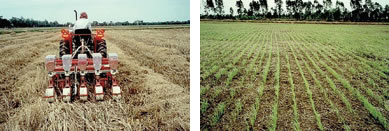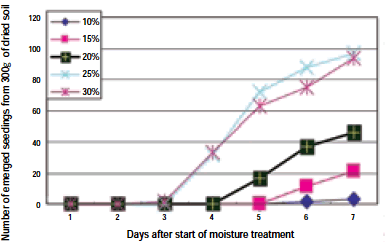Technologies for rainfed rice production in Northeast Thailand
Description
[Objectives]
The paddy fields of Northeast Thailand account for 55% of paddy area in the country and play a critical role in national food production. However, yield of rice is low and fluctuates due to the rainfed condition without irrigation. Shortage and rising cost of labor threaten the sustainability of production with conventional hand transplanting. To overcome these constraints, a set of technologies was developed for efficient water utilization.
[Results]
Introduction of dry direct seeding of rice was compatible to irregular rainfall and labor shortage. Growth and yield of direct seeded rice matched those of transplanted rice; and no-tillage was superior to tillage when the amount of rainfall was scarce as a result of higher soil moisture under undisturbed soil conditions. A no-tillage seeder with rotary disk and drill seeder was manufactured and applied in large-scale field trials, which resulted in equal or higher rice yield compared with vicinal transplanted fields (Fig. 1).
Weed control based on soil moisture regime was developed to suppress the dominant paddy weed species, Cyperaceae. At the soil moisture rates of 20%, emergence of Cyperacea was markedly inhibited (Fig. 2), while the direct seeded rice variety "KDML105" emerged vigorously. The optimum sowing time should be adjusted in order to facilitate adequate germination of rice while suppressing the emergence of weeds.
Paddy fields with dikes surrounded by thick plastic sheets or solidified by soil conditioner (magnesium compounds) were constructed to prevent water leakage. Changes in the depth of standing water before and after construction proved the enhanced water holding capacity of paddy fields with the implementation of both treatments (Fig. 3).
Figure, table
-
Fig. 1. Large-scale field trial for no-tillage direct seeding cultivation of rice. -
Fig. 2. Emergence of Cyperaceae weeds at different soil moisture rates in the soil of rainfed paddy fields.
- Affiliation
-
Japan International Research Center for Agricultural Sciences Crop Production and Environment Division
-
Department of Agriculture Thailand
- Term of research
-
FY2001 (FY1996-2001)
- Responsible researcher
-
KABAKI Nobuyuki ( Crop Production and Environment Division )
TAMURA Haruo ( Research Planning and Coordination Division )
ARROMRATANA Uthai ( Department of Agriculture Thailand )
NAGARA Tawachai Na ( Department of Agriculture Thailand )
- ほか
- Publication, etc.
-
N. Kabaki, H. Tamura, S. Fujimori, H. Morita, B. Uraipong, U. Arromratana and T. N. Nagara (2003): Development of a comprehensive series of technologies for lowland cropping systems in Northeast Thailand. JARQ.
- Japanese PDF
-
2001_09_A3_ja.pdf865.25 KB
- English PDF
-
2001_08_A4_en.pdf142.74 KB


